Summary
- Watching
The Lord of the Rings
and
The Hobbit
in release order is the most authentic way to experience the story as intended by the writers. -
The Hobbit
movies assume familiarity with characters from the original trilogy, making them more enjoyable for those with background knowledge of
The Lord of the Rings
. -
The Rings of Power
series takes place before
The Lord of the Rings
and
The Hobbit
, following a young Galadriel’s attempt to stop Sauron’s rise to power, but it takes liberties with Tolkien’s writings.
Peter Jackson’s The Lord of the Rings movies make up one of the most popular fantasy series ever put to screen, but there are multiple different viewing orders that make sense for this story. The movies are based on the works of British author J.R.R. Tolkien, whose original fantasy books take place in Middle-earth and follow a wide selection of Humans, Elves, Dwarves, and Hobbits as they battle against the dark forces of evil that threaten their universe.
Since Peter Jackson’s two trilogies take place at completely different points in time, audiences are now given a choice regarding how they want to experience this story. There are pros and cons to both Lord of the Rings viewing orders (release order and chronological order), with each option revealing information at different times and changing the way certain plot twists and surprises work. Plus, with the release of The Rings of Power on Amazon Prime Video, the cinematic timeline has become even more complex and non-linear.
The Lord of the Rings: The Motion Picture Trilogy
The Lord of the Rings movies were and are epic and one can argue that they can only be experienced on the big screen. But, these are the types of cinematic titans that Blu-ray was made for. The Lord of the Rings: The Motion Picture Trilogy is the special edition Blu-ray at its best.
- Studio
- Warner Bros
- Run Time
- 11 hrs 21 mins
- Director
- Peter Jackson
How Many Lord Of The Rings Movies Are There?
There Are Currently Eight Lord Of The Rings Movies
There are a total of eight movies adapted from J.R.R. Tolkien’s Middle-earth books, six in Peter Jackson’s modern series and two animated movies released in 1978 and 1980 respectively. That breaks down into three The Lord of the Rings movies and three The Hobbit movies, set before them in the Tolkien cinematic timeline. The first movie adapted from Tolkien’s books was the 1978 animated The Lord Of The Rings, directed by Ralph Bakshi. That was followed in 1980 by a Rankin-Bass animated adaptation of The Return of the King. Jackson’s LOTR trilogy then kicked off in the early 2000s.
|
Movie |
Release Year |
|
Ralph Bakshi’s The Lord Of The Rings |
1978 |
|
Bass & Rankin’s The Return of the King |
1980 |
|
The Lord of the Rings: The Fellowship of the Ring |
2001 |
|
The Lord of the Rings: The Two Towers |
2002 |
|
The Lord of the Rings: The Return of the King |
2003 |
|
The Hobbit: An Unexpected Journey |
2012 |
|
The Hobbit: The Desolation of Smaug |
2013 |
|
The Hobbit: The Battle of the Five Armies |
2014 |
Warner Bros. now has plans for multiple new LotR movies adapted from the books, with a new live-action series, the upcoming The Lord of the Rings: The War of the Rohirrim movie and Amazon’s Rings of Power season 2 incoming.
The LOTR Movies & Hobbit Movies In Order (By Release)
The Best Way To Watch The Lord Of The Rings Movies
Watching The Lord of the Rings and The Hobbit in the order these movies were released is the most authentic way of experiencing the story, with everything happening in the order the writers intended. The characters are introduced when they should be, their arcs happen naturally, and Jackson’s direction guides the audience gently through the story without much confusion. For new audiences, watching The Lord of the Rings in release order undoubtedly makes the most sense.
The Lord Of The Rings Movies In Order By Release Date
|
The Lord of the Rings: The Fellowship of the Ring |
December 19, 2001 |
|
The Lord of the Rings: The Two Towers |
December 18, 2002 |
|
The Lord of the Rings: The Return of the King |
December 17, 2003 |
The Hobbit Movies In Order By Release Date
|
The Hobbit: An Unexpected Journey |
December 14, 2012 |
|
The Hobbit: The Desolation of Smaug |
December 13, 2013 |
|
The Hobbit: The Battle of the Five Armies |
December 17, 2014 |
While The Hobbit trilogy is a prequel to The Lord of the Rings, the two series are actually best enjoyed in reverse order. The importance of this viewing order becomes clear once audiences reach Jackson’s The Hobbit movies. These sequels assume that audiences are already familiar with characters from the original trilogy, including Gandalf, Galadriel, and Saruman, inserting them into this story without much explanation.
This is just one of many differences between The Hobbit movies and the book. A good background knowledge of The Lord of the Rings will really help audiences make the most of this trilogy, enabling them to recognize characters and locations as soon as they appear.
The Lord Of The Rings Franchise In Order Of Events
The Saga In Chronological Order (Including The Rings Of Power)
Watching The Lord of the Rings movies and TV shows in chronological order is simpler than many other franchises, as the stories neatly follow on from one-another outside an incredibly limited number of scenes (such as the opening of The Hobbit: An Unexpected Journey, which has a brief moment with Frodo and the older Bilbo).
While Amazon’s The Lord of the Rings: The Rings of Power is technically part of the Peter Jackson Lord of the Rings canon, it does spiritually pay homage to the acclaimed cinematic trilogy in a number of ways — enough so that, when viewing the story in chronological order, it fits in nicely as a precursor to The Hobbit trilogy. It’s not essential viewing though, especially since The Rings of Power takes place millennia prior to the events of The Hobbit.
Fans wanting to watch all the live-action Lord of the Rings content chronologically should view the series and movies in the following order (with The Rings of Power being considered optional, especially since it is still ongoing):
|
Movie/Show |
Release Year |
|
The Lord of the Rings: The Rings of Power |
2022-Present |
|
The Hobbit: An Unexpected Journey |
2012 |
|
The Hobbit: The Desolation of Smaug |
2013 |
|
The Hobbit: The Battle of the Five Armies |
2014 |
|
The Lord of the Rings: The Fellowship of the Ring |
2001 |
|
The Lord of the Rings: The Two Towers |
2002 |
|
The Lord of the Rings: The Return of the King |
2003 |
The Hobbit: An Unexpected Journey (2012)
While it was released over a decade after The Fellowship of the Ring, the first movie chronologically in Peter Jackson’s Middle-earth saga is The Hobbit: An Unexpected Journey. Tolkien’s novel The Hobbit was written prior to his The Lord of the Rings trilogy and takes place several decades earlier, focusing on the adventures of a younger Bilbo Baggins and explaining how he discovered The One Ring.
The Hobbit: An Unexpected Journey is the first movie in Jackson’s prequel trilogy, and therefore, the first movie in the cinematic timeline. The story follows a young Bilbo Baggins as he’s recruited by Gandalf to reclaim stolen treasure from a dangerous dragon named Smaug who lives in an old mountain. It’s an adaptation of the first act of Tolkien’s novel of the same name, leading up to the gang’s battle with Azog. However, the movie also introduces several storylines that aren’t part of Tolkien’s novel, and it includes the presence of characters such as Galadriel and Saruman.

Related
10 Lord Of The Rings & Hobbit Changes To Tolkien’s Books That Went Too Far
Peter Jackson made many changes to Tolkien’s Lord of the Rings and The Hobbit for his movies, and not all of them went over well with viewers.
The Hobbit: The Desolation Of Smaug (2013)
While J.R.R. Tolkien’s The Hobbit novel was a single book, Peter Jackson split the story into three sections when adapting the story for the big screen, breaking The Hobbit down into three distinct movies. An Unexpected Journey covers the start of Bilbo’s journey and establishes the overarching plot of the wider trilogy, a story which continues next in 2013’s The Hobbit: The Desolation of Smaug.
The following movie, The Hobbit: The Desolation of Smaug, takes place moments after the conclusion of An Unexpected Journey, as Bilbo and his friends continue their travels and encounter the evil dragon that’s been guarding the treasure they seek. It picks up right after the gang’s rescue by the eagles and follows them as they arrive at the Lonely Mountain. The film ends with Smaug’s decision to wreak havoc on Laketown as the dwarves arrive to reclaim their home.
The Hobbit: The Battle Of The Five Armies (2014)
The final chapter in Peter Jackson’s The Hobbit trilogy is 2013’s The Hobbit: The Battle of the Five Armies, which is perhaps the closest in scale to the epic scope of the directors The Lord of the Rings trilogy. Once again, the final installment in The Hobbit trilogy picks up directly after the conclusion of The Desolation of Smaug, largely following the battle that ensued between the dragon, Bilbo’s company, the Dwarves, the Elves, and several other armies that came to reclaim the land.
It’s an exciting conclusion to the trilogy, leading right up to Bilbo’s return to The Shire, where he remains until his appearance in The Fellowship of the Ring. It’s this adventure that Bilbo is seen writing about at the beginning of the first Lord of the Rings movie, and the ending of The Battle of the Five Armies serves as an excellent bridge to the events of The Fellowship of the Ring.
The Lord Of The Rings: The Fellowship Of The Ring (2001)
The Lord of the Rings trilogy takes place 60 years after The Hobbit, following Bilbo’s cousin, Frodo (whom he refers to as his nephew), as he attempts to destroy the One Ring that Bilbo uncovered during the earlier story. 2001’s The Fellowship of the Ring introduces audiences to most of the series’ important characters, sending them off on their adventure and building the relationships that will be followed for the remainder of the trilogy.
While it’s technically a sequel to The Hobbit, viewing Peter Jackson’s prequel trilogy isn’t at all essential, as nothing that transpires in The Fellowship of the Ring or the two movies that follows requires knowledge of The Hobbit.The Fellowship of the Ring‘s ending sees Frodo and Sam splitting up from the group as their friends attempt to rescue Merry and Pippin from the Orcs.
The Lord Of The Rings: The Two Towers (2002)
The Lord of the Rings: The Two Towers
The Lord of the Rings: The Two Towers is a Fantasy film by director Peter Jackson and is based on The Two Towers book by author J. R. R. Tolkien. A sequel to The Lord of the Rings: The Fellowship of the Ring, this installment continues Frodo’s journey to take the One Ring to Mount Doom to destroy it.
- Release Date
- January 15, 2002
- Runtime
- 179minutes
The Two Towers bridges the gap between the first and final Lord of the Rings movies, splitting up the Fellowship and introducing several new locations on the road to Mordor. The story is mostly split into three parts: Frodo and Sam’s journey to Mordor with Gollum, Merry and Pippin’s interactions with the Ents, and the remaining heroes’ attempts to save Rohan from Sauron’s armies.
The story culminates with the famous Battle of Helm’s Deep, which sets the stage for the last installment of the trilogy. While it’s the middle segment of the wider story, many key events take place in The Two Towers, and it also features one of the franchise’s most epic battle sequences when the Urak-Hai invade Helm’s Deep. The Two Towers also stands as a unique testament to both J.R.R. Tolkien’s storytelling ability and Peter Jackson’s skills as a director, since, for the most part, it works just as well as a standalone story as it does part of a wider narrative.
The Lord Of The Rings: Return Of The King
Peter Jackson’s The Lord of the Rings trilogy culminates in 2003’s The Lord of the Rings: The Return of the King, which brings all the various narrative threads to a head and sees the united people’s of Middle-earth take their last stand against the dark lord Sauron and the forces of Mordor. Return of the King is the final entry in Peter Jackson’s Lord of the Rings trilogy, and as such, the final chronological entry in this cinematic universe.
The story follows Frodo and his friends as they battle against Sauron and eventually destroy the One Ring, bringing peace back to Middle-Earth. Return of the King wraps the story up perfectly, and it went on to win Best Picture at the Academy Awards. It’s also the latest chronological point J.R.R. Tolkien wrote on when it comes to the history of Middle-earth, as very little was disclosed about what happened after The Return of the King and the fourth age of Middle-earth that followed.

Related
Lord of the Rings: Return of the King’s Oscars Record Explained
The Lord of the Rings: Return of the King had a record-breaking night at the 2004 Oscars, but only following an extensive campaign by New Line Cinema.
How The Rings Of Power Fits Into The Lord Of The Rings Franchise
A New Addition To The Mythos
The Rings of Power is a series that takes place long before The Lord of the Rings and The Hobbit, during the First Age of Middle-earth. It follows a much younger version of Galadriel as she attempts to stop Sauron’s rise to power, which ties neatly into the movies that follow many years later. Although The Rings of Power technically isn’t an official prequel, it works within the timeline of Jackson’s films, as it’s still following Tolkien’s history of Middle-earth. However, the series takes liberties with Tolkien’s writings, so it’s hard to say if it’s as faithful as the Lord of the Rings movies.
The first season of The Rings of Power stars Morfydd Clark as Galadriel, Robert Aramayo as Elrond, Charlie Vickers as Halbrand, Maxim Baldry as Isildur, and Ismael Cruz Cordova as Arondir. The Rings of Power is a big change from The Lord of the Rings, and it has plans to continue for several more seasons. Whether it will become as highly regarded as the movies remains to be seen, but it’s certainly doing a good job of expanding upon Tolkien’s vast lore.










